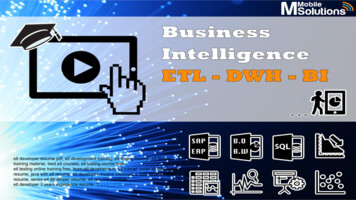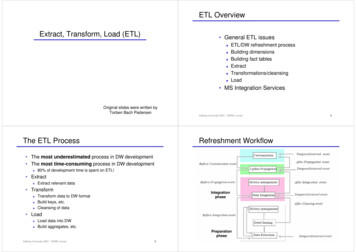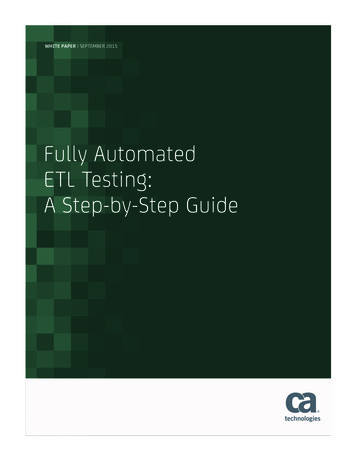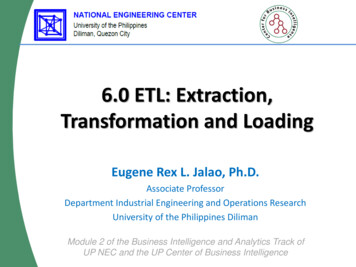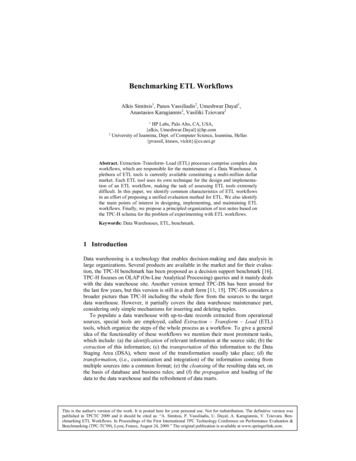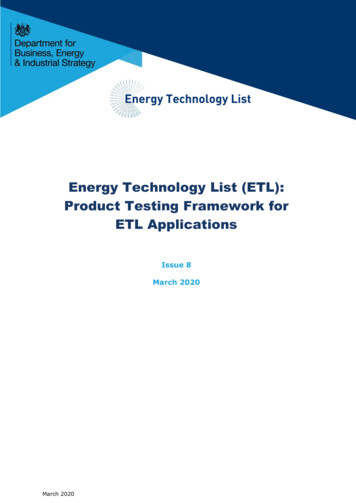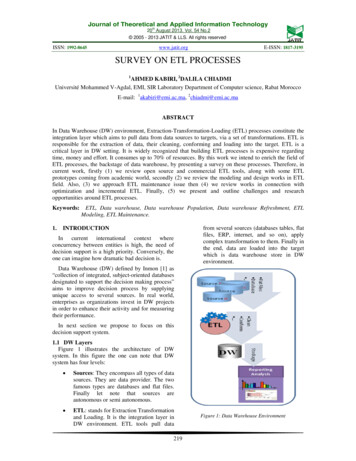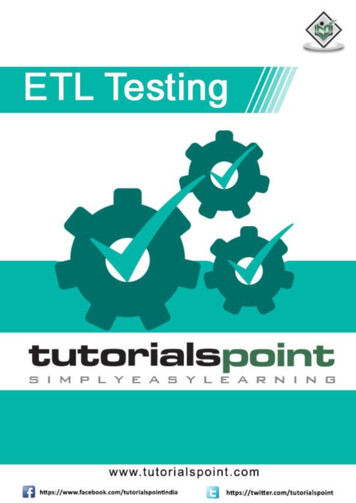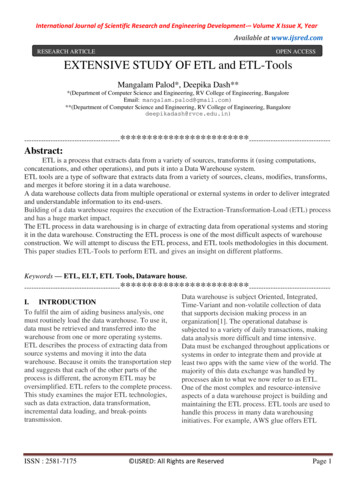
Transcription
International Journal of Scientific Research and Engineering Development-– Volume X Issue X, YearAvailable at www.ijsred.comRESEARCH ARTICLEOPEN ACCESSEXTENSIVE STUDY OF ETL and ETL-ToolsMangalam Palod*, Deepika Dash***(Department of Computer Science and Engineering, RV College of Engineering, BangaloreEmail: mangalam.palod@gmail.com)**(Department of Computer Science and Engineering, RV College of Engineering, -------------------------------Abstract:ETL is a process that extracts data from a variety of sources, transforms it (using computations,concatenations, and other operations), and puts it into a Data Warehouse system.ETL tools are a type of software that extracts data from a variety of sources, cleans, modifies, transforms,and merges it before storing it in a data warehouse.A data warehouse collects data from multiple operational or external systems in order to deliver integratedand understandable information to its end-users.Building of a data warehouse requires the execution of the Extraction-Transformation-Load (ETL) processand has a huge market impact.The ETL process in data warehousing is in charge of extracting data from operational systems and storingit in the data warehouse. Constructing the ETL process is one of the most difficult aspects of warehouseconstruction. We will attempt to discuss the ETL process, and ETL tools methodologies in this document.This paper studies ETL-Tools to perform ETL and gives an insight on different platforms.Keywords — ETL, ELT, ETL Tools, Dataware ---Data warehouse is subject Oriented, Integrated,I. INTRODUCTIONTime-Variant and non-volatile collection of dataTo fulfil the aim of aiding business analysis, onethat supports decision making process in anmust routinely load the data warehouse. To use it,organization[1]. The operational database isdata must be retrieved and transferred into thesubjected to a variety of daily transactions, makingwarehouse from one or more operating systems.data analysis more difficult and time intensive.ETL describes the process of extracting data fromData must be exchanged throughout applications orsource systems and moving it into the datasystems in order to integrate them and provide atwarehouse. Because it omits the transportation step least two apps with the same view of the world. Theand suggests that each of the other parts of themajority of this data exchange was handled byprocess is different, the acronym ETL may beprocesses akin to what we now refer to as ETL.oversimplified. ETL refers to the complete process. One of the most complex and resource-intensiveThis study examines the major ETL technologies,aspects of a data warehouse project is building andsuch as data extraction, data transformation,maintaining the ETL process. ETL tools are used toincremental data loading, and break-pointshandle this process in many data warehousingtransmission.initiatives. For example, AWS glue offers ETLISSN : 2581-7175 IJSRED: All Rights are ReservedPage 1
International Journal of Scientific Research and Engineering Development-– Volume X Issue X, YearAvailable at www.ijsred.comcapabilities while also utilising database capabilities.Some construct their own ETL tools and techniques,either into or out of the database.Aside from extraction, transformation, andloading, there are a few other tasks that are criticalfor a successful ETL deployment as part of the datawarehouse's everyday operations and futureupgrades. Data is extracted from multiple,heterogeneous data sources, transformed, and thenloaded into the data warehouse using the ETL tool.II. ETLETL consists of three processes that allow data tobe sent from source to destination.A. ExtractionThe system determines the required data sources aswell as the fields to be extracted from the sources,during the extract phase of ETL. Before data can bemoved to a new site, it must first be retrieved fromits original place.In this stage of the ETL system, data is taken fromthe source system and placed in the stagingarea.Data may be obtained in its raw form from anumber of sources, including older systems anddatabases.B. TransformationRules and regulations that assure data quality andaccessibility can be introduced at this stage of theETL process, as well as a set of functions that canbe applied to the data that has been extracted.The data transformation process is divided intoseveral sub-processes: Cleaning entails correctingdata inconsistencies and missing values. The term"standardisation" refers to the process of applyingrules to a data set. The process of deleting oreliminating redundant data is known asdeduplication. During verification, unusable data isremoved, and abnormalities are identified. Sortingis the process of categorising data.The most significant phase in the ETL process istransformation, which is usually regarded as themost important. Data transformation improves dataintegrity and guarantees that data arrives at its newplace fully compliant and ready to use.ISSN : 2581-7175In its current condition, the data collected from thesource server is useless.C. LoadingAs the final stage in the ETL process, the converteddata is imported into a new destination. Data can beloaded in bulk (full load) or at predefined intervals(interval loading) (incremental load).In an ETL full loading scenario, everything thatcomes off the transformation assembly line isturned into new, unique entries in the datawarehouse. Though this is sometimes useful forstudy, comprehensive loading leads in data sets thatgrow rapidly and become difficult to manage.A big volume of data must be put into a datawarehouse in a short amount of time (nights). As aresult, the loading procedure should be sped up.Incremental loading is a way of loading that is lesscomplete but more customizable. Incrementalloading compares fresh data to what's currently onhand, and only produces new entries if it finds freshand unique data.III.ETL V/S ELTIt is Extract, Load and Transform. The steps aresame as ETL, just the order of execution is differentin ELT. The difference between ETL and ELT isalso important for understanding ETL Tools.TABLE I DIFFERENCE BETWEEN THE ETL VS ELT IJSRED: All Rights are ReservedPage 2
International Journal of Scientific Research and Engineering Development-– Volume X Issue X, YearAvailable at www.ijsred.comETLWithin a ely afterextraction.Thedata is placed intothedatawarehouse after ithasbeentransformed.ELTSystemThe data isFlowextracted first,and then fedinto the targetdatasystem.Onlyafterwards, foranalyticalpurposes,ispart of the datachanged on ontransmitting the alwaysdatatothe stationedatDatawarehousedatabase.DB, the stagingserver changes it.DatasetsSmallerdataWhensets that require dealingwithcomplicatedlarge amountsprocessingare of structuredbest served by andETL.unstructureddata, ELT isthe best option.ProcessingViewsareCreating andstyleand createdusing maintaining adAnalysisnumerous scripts, hoc views istherefore deleting inexpensive.a view involvesdestroying data.MaintenanHighNocemaintenance-must maintenance,choose which data since completetoloadand dataistransform,and available.must do it again ifdestroyed or if themaindatarepository is to beenhanced.ISSN : 2581-7175IV.ETL TOOLSA. XPLENTYXplenty is a cloud-based ETL and ELT dataintegration tool that allows you to connect manydata sources with ease. This platform provides asimple and straightforward visual interface forcreating data pipelines between multiple sourcesand destinations. It includes more than 100 majordata stores and SaaS apps. MySQL, MongoDB,PostgreSQL, Amazon Redshift, Google CloudPlatform, Facebook, QuickBooks, and dozens ofother applications are on the list[4]. It’s otherbenefits include scalability, security, andoutstanding customer service. Field LevelEncryption, for example, is a new feature in Usersmay encrypt and decode data fields using their ownencryption key using the tool. It also ensuresregulatory compliance with legislation such asHIPPA, GDPR, and the CCPA.B. TalendTalend Data Integration is, an open-source ETL(enterprise data warehousing) data integration tool,a free open-source solution that simplifies ETLtesting[6]. It comes with all ETL testing features aswell as a continuous delivery method. The user canrun ETL jobs on a remote server with a range ofoperating systems using Talend Data IntegrationTool. ETL testing guarantees that data is translatedwithout loss from the source system to the targetsystem and that the transformation rules arefollowed. The Talend platform works with both onpremises and cloud data sources and comes withhundreds of pre-built integrations. Any relationaldatabase, flat files, and other file types aresupported by Talend Data Integration. The ETLprocess is simplified and developed with the help ofan integrated GUI. We can identify flaws at aninitial stages with the help of Talend, whichhelps save money. Talend is capable of swiftlydetecting business uncertainty and consistency intransformation rules. Switching is possiblein Talend. With thorough performance statistics,Talend can track real-time flow of data. IJSRED: All Rights are ReservedPage 3
International Journal of Scientific Research and Engineering Development-– Volume X Issue X, YearAvailable at www.ijsred.comC. Informatica PowerCenter ToolInformatica PowerCenter is an enterprise dataintegration platform for ETL jobs. Informatica'sPowerCenter is simply one of several cloud datamanagement technologies in the Informatica suite.PowerCenter has a reputation for great performanceand compliance with a wide range of data sources,including SQL and non-SQL databases, as anenterprise-class, database-neutral solution[3]. It's abatch-based tool. Informatica PowerCenter hassome drawbacks, including high cost and a hardlearning curve, which may prevent smaller firmswith limited technical expertise. Informatica uses anETL architecture to process data. WorkflowManager, Monitor, Designer, and RepositoryManager are the four main components ofPowerCenter. A data engineer must employ each ofthese components in a complex yet systematicdesign sequence to create a full ETL pipeline. Italso has a cloud counterpart that allows users toaccess repositories on the business premises andperform transformation operations in the cloud.It's change connectors support AWS DynamoDB,AWS Redshift, and other popular cloud datawarehouses. It also supports a number of datastorage and software-as-a-service options. Becauseof obligatory compliance requirements, InformaticaPowerCenter is better suited for enterprises thatrequire enterprise-grade security and datagovernance within their on-premise data. EvenInformatica PowerCenter's cloud technology isbetter suited for on-premise data, with a focus ondata protection[2].D. PentahoPentaho is designed for on-premise, batch ETL usecases. It provides data integration and processingcapabilities from a variety of data sources. Pentahoalso places a strong bet on hybrid cloud and multicloud architectures. Pentaho relies on theinterpretation of ETL methods stored in XMLformat to function. Pentaho is superior than Talendfor ad-hoc analysis because it does not require codegeneration. Pentaho does not provide costinformation up front. Developers can't alwaysISSN : 2581-7175figure out what's causing the error because therearen't any specific explanations on the loggingscreen. When enterprises opt for open source ETLtechnologies in an on-premise ecosystem, Pentahois frequently used.E. AWS GlueAWS offers Glue, a cloud-based real-time ETLsolution that is available on a pay-as-you-go basis.AWS glue is largely batch-oriented, although it canalso enable lambda-based near-real-time use cases.If the majority of the data sources from which youwant to ingest data are on AWS, Glue makes itsimple to ETL the data. Outside of the AWSecosystem, support for sources and destinations islimited[5]. Glue provides various unique features,such as an integrated data catalogue and automatedschema discovery. It can construct a serverless fullfledged ETL pipeline using AWS Glue and lambdafunctions. Glue also offers Dev Endpoints andNotebooks, which provide a dedicated Spark clusteron which you can run jobs indefinitely, making iteasier to build and test scripts. Because I am unableto use them in my development environment, I amunable to comment on their functionality.F. QuerySurgeThe QuerySurge tool was created to test DataWarehouses and Big Data. It also ensures that thedata collected and loaded from the source system tothe destination system is accurate and formattedcorrectly. With QuerySurge, any errors ordifferences can be instantly identified. QuerySurgeis an ETL and Big Data testing tool that isautomated. It improves data quality and speeds uptesting cycles. The Query Wizard is used to validatedata. It saves time and expense by automating themanual efforts and schedule test for a specifiedperiod. ETL testing is supported by QuerySurge fora variety of platforms, including IBM, Oracle,Microsoft, and others. It enables the creation of testscenarios and test suits, as well as customisedreports, without the need for SQL knowledge. Itcreates the email using an automated method. Viathe ETL process, QuerySurge verifies, converts, IJSRED: All Rights are ReservedPage 4
International Journal of Scientific Research and Engineering Development-– Volume X Issue X, YearAvailable at www.ijsred.comTable II . ResultETLELTReal-TimeXPlentyTalend InformaticaPowerCenterTool and upgrades data. It's a commercial solution thatuses the ETL procedure to link sources and enhancedata.V. RESULTSThe results are depicted in Table 2 above.VI.CONCLUSIONSWe explored both the ETL and ELT approaches forloading data into a data warehouse in this study.This study discusses the advantages anddisadvantages of both techniques.The paper alsoshowed which technique is better than the othersand in which conditions.All tools have their own set of strengths anddisadvantages, some of them has the advantage dueto its maturity and reliability, as well as itssuitability for enterprise-scale deployments,excellent support, speed, implementation, and easeof usage. Despite the fact that some of them are free,its lack of support, documentation, and large-scaledeployments making it unsuitable for commercialISSN : 2581-7175PentahoAWS GlueQuerySurge use, particularly with financial and cloud-basedsystems.ACKNOWLEDGMENTI would like to acknowledge the support providedby teacher’s of Department of Computer Scienceand Engineering, RV College of Engineering,Bangalore, India through their assistance in theresearch work.REFERENCES[1][2][3][4][5][6][7]Barateiro, J., & Galhardas, H. (2005). A Survey of Data QualityTools. Datenbank-Spektrum 14, 15-21Kimbal, R., Reeves, L., Ross, M., & Thornthwaite, W. (1998). TheData Warehouse Lifecycle Toolkit: Expert Methods for Designing,Developing, and Deploying Data Warehouses. John Wiley & tp://www.informatica.com/products services/powercenter/Pages/index.aspxXplenty. Product’s web page whats-new-cards.sortby .sortorder descTalend, Products web page at https://www.talend.com/Carreira P., Galhardas, H., Pereira, J., Martins, F., & Silva, M.(2007). On the performance of one-to-many data transformations.Proceedings of the Fifth International Workshop on Quality inDatabases (QDB 2007), pp.: 39-48, in conjunction with the VLDB2007 conference, Vienna, Austria, September 23, 2007 IJSRED: All Rights are ReservedPage 5
it in the data warehouse. Constructing the ETL process is one of the most difficult aspects of warehouse construction. We will attempt to discuss the ETL process, and ETL tools methodologies in this document. This paper studies ETL-Tools to perform ETL and gives an insight on different platforms. Keywords — ETL, ELT, ETL Tools, Dataware house.
